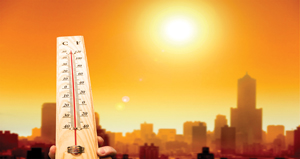Flex Alerts. The Heat is ON
- Details
- Category: Community News
- Published on Friday, 25 August 2017 12:01
- Written by CHIN THAMMASAENGSRI
 Welcome to the peak of summer 2017 in Los Angeles. It comes complete with sun, humidity, and occasionally three-digit temperatures. These can combine to bring you the always ill-timed power outage.
Welcome to the peak of summer 2017 in Los Angeles. It comes complete with sun, humidity, and occasionally three-digit temperatures. These can combine to bring you the always ill-timed power outage. In fact, California has a name for days like these: Flex Alert days. Flex Alerts leave Californians wondering why their tax dollars don’t ensure an outage-free power grid. Some power outages occur due to overloaded grid systems that shut down to prevent damage, while others are due to the simple yet catastrophic failure of equipment.
Let’s break down the technobabble by creating a Flex Alert inside of your own home. The setting is NOW and you’ve just purchased a neat portable air conditioner from the hardware store. You set it up in the living room where your desktop computer, entertainment center, aquarium, and lamps are also located. Up to this point, you’ve never had a problem with power, so you plug the air conditioner into an outlet, set it to its highest setting (for maximum cooling), and turn it on. For an hour or so, it works well and then NOTHING; you lose power to that room. Your first instinct is to check your main switch panel where you find the “breaker” has tripped. In this case, your system sensed an imminent overload and shut itself down to save the rest of your electrical system. The second scenario is a little more common with older systems which allow can wires behind the wall to heat up and result in a fire which is dangerous and destructive. If you can believe it, both resulted from adding a device that pulled MORE POWER THAN THE SYSTEM WAS MEANT TO CARRY.
Let’s go from the MICRO to the MACRO and look at the same situations on a city & state level. When the temperature goes up, electrical demand from me, you, your neighbors, your city, and your state multiply exponentially on our often mentioned “power grid.” The California ISO or Independent Systems Operator issues a Flex Alert to get citizens to cut electrical use especially during peak hours of the day which are roughly 9AM to 6PM. When you hear about outages or “Rolling Black Outs” in a particular city or community, that’s the grid shutting down a particular zone to keep other zones with power on. Once the levels lower, those dark zones usually come back on.
These shut downs can last minutes, hours, or even days. Catastrophic failures take place when power vaults, generating equipment, and transfer equipment overload, short out, or simply explode. Southern California has experienced these events such as the Long Beach power outage of 2015 which lasted for days and saw underground vaults explode sending manhole covers flying. In 2017, Los Angeles saw catastrophic failures in the Park La Brea/Grove area which killed power for nearly three days in July. Around that same time, Northridge experienced a catastrophic failure at one of its DWP sub-stations and resulted in a major fire that required multiple resources from the LAFD to extinguish. As of this writing, the LAFD and DWP are still trying to pinpoint the exact origin of this failure though you can be assured it was due to increased usage of the system over several unusually hot & humid days.
What can you do proactively? Utilities tell you to dial back power usage. Turn off lights & other non-essential equipment when you are not home or using them. Lower your thermostat as well to about 70 degrees also when you are not home. Finally, avoid using appliances during peak hours of the day. If you are in an outage, use the items in your disaster prep kit (the one you SHOULD have) including flashlights, portable radios, hand held radios for communications, and generator equipment if you have it. Certain food items will remain good as long as they are kept cold, so limit opening and closing that refrigerator door please. Check on neighbors, especially the elderly or infirmed. A knock at their door CAN SAVE A LIFE. Otherwise, ride it out until utilities are restored. I say be proactive and prevent such an event, but if you’re caught with your lights out, you know what to do.
News Category
-
Community News
In The CD 10 Race, Only One Candidate Has Earned The Right To Lead The District
 reprinted from CityWatch LA October 07 2024ELECTION 2024 - When you know the story of how Heather...
reprinted from CityWatch LA October 07 2024ELECTION 2024 - When you know the story of how Heather...
-
Neighborhood Councils
NEIGHBORHOOD COUNCIL UPDATE
Local Neighborhood Councils are a proactive way to become involved in your relationship with the...
-
City News
Communities Preparing for Disaster
 by Bob Gelfand CitywatchLAGELFAND’S WORLD - In a week of sometimes depressing news, I would like...
by Bob Gelfand CitywatchLAGELFAND’S WORLD - In a week of sometimes depressing news, I would like...
-
Crime Reports
HOW TO TELL IF YOU ARE THE TARGET OF A PHONE SCAM
 Every year, thousands of people lose money to telephone scams — from a few dollars to their life...
Every year, thousands of people lose money to telephone scams — from a few dollars to their life...
-
Local Development
WHAT IS DESTINATION: PICO AND WHY IS IT DOING ALL THOSE NICE THINGS ON PICO?
 Destination: Pico is a community nonprofit working to make Pico Boulevard more walkable, vibrant,...
Destination: Pico is a community nonprofit working to make Pico Boulevard more walkable, vibrant,...
Today2
Yesterday10
Week57
Month57
All988385
Kubik-Rubik Joomla! Extensions
Yesterday10
Week57
Month57
All988385
Currently are 139 guests and no members online
Kubik-Rubik Joomla! Extensions




